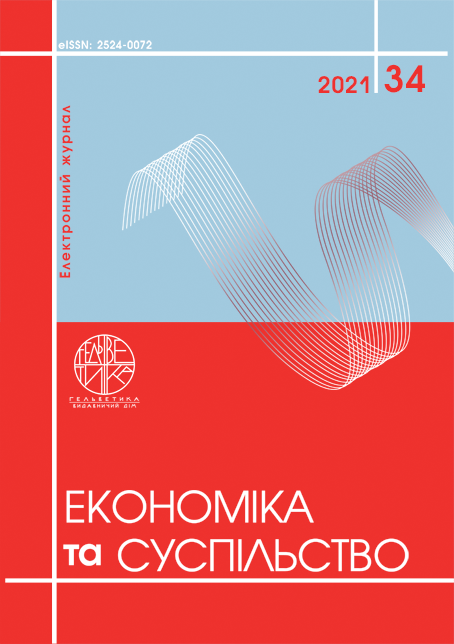ASSESSING THE PROFITABILITY OF THE BANKING GROUP
Abstract
The article is devoted to the current problem of improving the reliability of profitability assessment using the example of a banking group. It has been shown that most previously developed profitability level prediction models are based on linear regression, without comparing them with non-linear models. In the work, the nature of the existing dependence of the level of profitability of the banking group on the performance of two participants in this group was analyzed. The construction of the correlation matrix and the inverse to it made it possible to identify a high level of dependence between the profitability levels of the members of the banking group. Therefore, a set of one-factor regression models of the profitability level of the banking group was built using the indicators of each group member separately from the other. Based on the information of each group, a linear, logarithmic and polynomial model was built. The best models for each member of the banking group were selected based on the determination factor, the Fisher criterion, and the average absolute error percentage. It was revealed that for one member of the banking group, the best model for predicting profitability was the polynomial model, for another - linear. Based on the selected models, a model was built that gives an average estimate from these models. In order to improve the quality of the models obtained, it was decided to use machine learning methods. Bagging was chosen as this method. A flowchart of the use of bagging to improve the quality of previously developed models was proposed. To implement the proposed algorithm, a Python program was developed using the Scikit-learn machine learning library. Using this method of machine learning made it possible: to find out the optimal number of samples for each of the selected models, to improve the quality of the developed models and to offer a two-factor model for assessing the profitability level of the banking group. The developed set of models can be used to assess the level of profitability and predict the impact of management decisions on the results of banking groups. It is proposed to use other methods of machine learning, such as a genetic algorithm and a random forest, when building future models.
References
Амбарчян М. Регресійна модель рівня прибутковості банківської групи. Вісник КНТЕУ. 2013. № 2. С. 84–97. URL: https://knutd.edu.ua/publications/pdf/Ukrainian_editions/Abramchan20150907.pdf
ВандерПлас Дж. Python для сложных задач: наука о данных и машинное обучение. СПб. : Питер, 2018.
Духновська Л.М., Павлов В.С. Прибутковість підприємства: сутність та ефективність управління. Науковий вісник Ужгородського національного університету. 2018. № 17, ч. 1. С. 100–103. URL: http://www.visnyk-econom.uzhnu.uz.ua/archive/17_1_2018ua/24.pdf (дата звернення: 25.01.2022).
Єпіфанова І.Ю., Гуменюк В.С. Прибутковість підприємства: сучасні підходи до визначення сутності. Економіка і суспільство. 2016. № 3. С. 189–192. URL: https://economyandsociety.in.ua/journals/3_ukr/33.pdf (дата звернення: 25.01.2022).
Ковальчук Н.О. Аналіз динаміки рівня прибутковості підприємств України в умовах викликів сьогодення. Східна Європа: економіка, бізнес та управління. 2019. № 2(19). С. 151–156. URL: http://www.easterneurope-ebm.in.ua/journal/19_2019/25.pdf
Оксенюк Т.М. Фактори підвищення прибутковості підприємства: еволюційний аспект. Науковий вісник Херсонського державного університету. 2015. № 13, ч. 3. С. 16–19. URL: http://www.ej.kherson.ua/journal/economic_13/87.pdf
Сисоєва І.М. Прогнозування прибутку підприємства в залежності від методів облікової політики. Економіка та держава. 2010. № 10. С. 93–94. URL: http://www.economy.in.ua/pdf/10_2010/26.pdf
Стригуль Л.С., Тур Г.Є., Нгуєн Т.М.Х. Ефективність та прибутковість: теоретичний аспект. Інфраструктура ринку. 2019. № 36. С. 287–292. URL: http://www.market-infr.od.ua/journals/2019/36_2019_ukr/47.pdf
Шапран Є.М., Сергієнко О.А., Білоцерківський О.Б. Прогнозування прибутковості підприємства ресторанного бізнесу та чинників впливу на його фінансові показники. Науковий вісник Ужгородського національного університету. 2020. № 30. С. 218–223. URL: http://www.visnyk-econom.uzhnu.uz.ua/archive/30_2020ua/44.pdf
Ambarchian, M. (2013) Rehresiina model rivnia prybutkovosti bankivskoi hrupy [Regression model of the level of profitability of the banking group]. Visnyk KNTEU, no 2, pp. 84–97. Retrieved from: https://knutd.edu.ua/publications/pdf/Ukrainian_editions/Abramchan20150907.pdf (in Ukrainian)
VanderPlas, J. (2018) Python dlia slozhnыkh zadach: nauka o dannыkh y mashynnoe obuchenye [Python Data Science Handbook: Essential Tools for Working with Data]. SPb.: Pyter. (in Russian)
Dukhnovska, L.M., & Pavlov, V.S. (2018) Prybutkovist pidpryiemstva: sutnist ta efektyvnist upravlinnia [Profitability of the enterprise: the essence and efficiency of management]. Naukovyi visnyk Uzhhorodskoho natsionalnoho universytetu, no 17, ch. 1, pp. 100–103. Retrieved from: http://www.visnyk-econom.uzhnu.uz.ua/archive/17_1_2018ua/24.pdf (in Ukrainian)
Yepifanova, I.Yu., & Humeniuk, V.S. (2016) Prybutkovist pidpryiemstva: suchasni pidkhody do vyznachennia sutnosti [Profitability of the enterprise: modern approaches to determining the essence]. Ekonomika i suspilstvo, no 3, pp. 189-192. Retrieved from: https://economyandsociety.in.ua/journals/3_ukr/33.pdf (in Ukrainian)
Kovalchuk, N.O. (2019) Analiz dynamiky rivnia prybutkovosti pidpryiemstv Ukrainy v umovakh vyklykiv sohodennia [Analysis of the dynamics of the level of profitability of Ukrainian enterprises in the face of current challenges]. Skhidna Yevropa: ekonomika, biznes ta upravlinnia, no 2(19), pp. 151–156. Retrieved from: http://www.easterneurope-ebm.in.ua/journal/19_2019/25.pdf (in Ukrainian)
Okseniuk, T.M. (2015) Faktory pidvyshchennia prybutkovosti pidpryiemstva: evoliutsiinyi aspekt [Factors of increasing the profitability of the enterprise: the evolutionary aspect]. Naukovyi visnyk Khersonskoho derzhavnoho universytetu, no 13, ch. 3, pp. 16–19. Retrieved from: http://www.ej.kherson.ua/journal/economic_13/87.pdf (in Ukrainian)
Sysoieva, I.M. (2010) Prohnozuvannia prybutku pidpryiemstva v zalezhnosti vid metodiv oblikovoi polityky [Profit forecasting of the enterprise depending on accounting policy methods]. Ekonomika ta derzhava, no 10, pp. 93–94. Retrieved from: http://www.economy.in.ua/pdf/10_2010/26.pdf (in Ukrainian)
Stryhul, L.S., Tur, H.Ye., & Nhuien, T.M.Kh. (2019) Efektyvnist ta prybutkovist: teoretychnyi aspekt [Efficiency and profitability: theoretical aspect]. Infrastruktura rynku, no 36, pp. 287–292. Retrieved from: http://www.market-infr.od.ua/journals/2019/36_2019_ukr/47.pdf (in Ukrainian)
Shapran, Ye.M., Serhiienko, O.A., & Bilotserkivskyi, O.B. (2020) Prohnozuvannia prybutkovosti pidpryiemstva restorannoho biznesu ta chynnykiv vplyvu na yoho finansovi pokaznyky [Forecasting the profitability of the restaurant business and factors of influence on its financial indicators]. Naukovyi visnyk Uzhhorodskoho natsionalnoho universytetu, no 30, pp. 218–223. Retrieved from: http://www.visnyk-econom.uzhnu.uz.ua/archive/30_2020ua/44.pdf (in Ukrainian)


